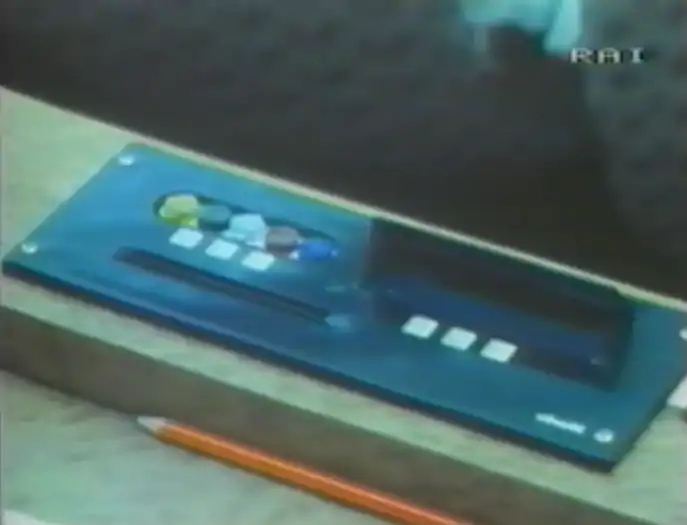Electronic voting systems for the European Parliament
The Electronic Voting Systems installed in Strasbourg, France, and Luxembourg by Olivetti, after winning an international tender [1] for the European Parliament in 1979 were built with a network of microprocessor controlled voting terminals connected by a custom-designed local area network to an Olivetti P6060 minicomputer.

The 420 terminals included an Intel 8748 single-chip microprocessor controlling the punched card reader, the voting keys, and the display lights, in addition to the serial interface to the LAN. The transmission was over 10 kilometers of simple unshielded twisted pair category 3 cable—the same cable used for telephone systems—installed inside the benches of the European Parliament Hemicycles in Strasbourg and Luxembourg. Communication was using a 19200 baud RS422 a polling-selecting software protocol controlled by the minicomputer.
An "Intelligent Communication Controller" with an Intel 8080 microprocessor was installed between the Olivetti P6060 and the network of the terminals to achieve the full speed of communication needed to meet the requirements of the European Parliament in terms of system execution time.[2]
In the first system installed in Strasbourg, France, used only once for a minor vote, the polling of the terminals had been controlled by the P6060 with an interpreted Basic software with response time so long to force Simone Veil, the Parliament President, to apologize to parliament saying that "la machine doit chauffer" - the machine must warm up. It did not fulfill the European Parliament system specifications. [3]
After the first system was installed in Strasbourg, it was determined that the interpreted basic software used by the P6060 was limiting the polling speed from the network. Therefore, an intelligent unit was installed to perform the polling selecting functions using an Intel 8080 microprocessor-controlled microprogrammed for the specific function. This unit was first installed in the second system of Luxembourg, where it was used for the first time fthe Parliament had the power to approve the Budget, voting during the session of 3-6 November 1980. Over 500 nominal votes were performed in just 4 hours. It would have taken about two hours for each of the 500 votes using the traditional manual procedures.[4] The Strasbourg system was then updated with a similar intelligent unit. The P6060 was later replaced with one of the newest Olivetti personal computers.
The terminals, the local area network, and the intelligent polling unit were designed and manufactured by an Olivetti's subcontractor: Elema Spa was Enrico Massetti's company [5] he was the general manager and the main designer.
The intelligent polling unit performed the additional function of a Firewall: any command arriving from the P6060 controlling computer was blocked except for the basic functions "Open secret Vote," "Open clear Vote," "Close Vote." The polling unit performed polling in sequence the voting terminals; the results were kept in the polling unit's memory, only total figures were sent to the P6060 in case of a secret vote.
The voting systems for the European Parliament and the Italian Senate were later updated and expanded by the Eurel Informatica Spa[6] a company that was founded by Enzo Costa, the former Olivetti engineer who was in charge of the original project for Olivetti when the company decided to exit the business of electronic voting systems in 1987.

The first time the system was used in Luxembourg, it failed miserably.[7] Enrico Massetti quick-thinking [8]and action saved the day for the Parliament and Olivetti and prevented it from becoming a total disaster. Enrico manually controlled the voting terminals' power at each of the 500 votes that took place that day. Enzo Costa, the Olivetti engineer in charge of the project, requested that the test software be incorporated with the terminal's operating firmware, and be activated when a voting button was pressed at power-up. When activated, the test software was continuously transmitting a square wave on the transmission line, effectively killing all network communication. With 430 people interacting with the system, someone would vote before the president declared the vote open, and the power to the terminals switched on automatically by the central computer.
References
- "The European Parliament electronic voting system tender specifications". Retrieved 2021-02-03.
- "European Parliament System Specifications". Retrieved 2021-02-03.
- "European Parliament System Specifications". Retrieved 2021-02-03.
- Massetti, Enrico (2021-01-25), The Debut of the First microcomputer Local Area Network in the world 1980! A REAL FIASCO! Turned into a success!, retrieved 2021-02-03
- "Retired visionary inventor – turned innovative publisher". Retrieved 2021-02-03.
- http://www.eurel.it/12?show_case=10
- "Local Area Network Failure – when it was first used". enricomassetti.com. Retrieved 2020-04-26.
- Massetti, Enrico (2020-04-29), LAN - its birth in 1980 TRAILER, retrieved 2021-02-03